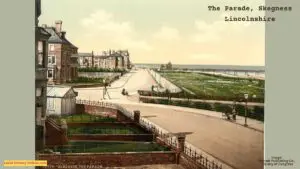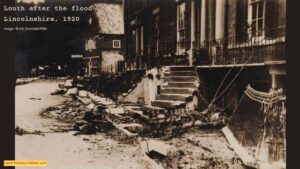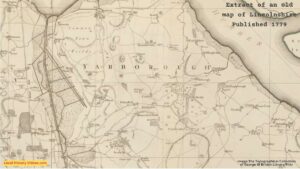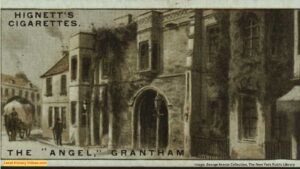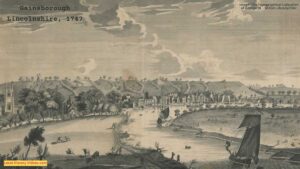Glimpse history through old images of Lincoln, an ancient cathedral city in the English county of Lincolnshire, UK.
The pretty UK city of Lincoln was given its first charter in 1157, by King Henry II. By then, the ancient settlement had been home to the Britons, Romans, Danes and Normans.
William the Conqueror’s men removed 166 houses in the 1060s to create a castle, which today is a tourist attraction and home to an original 1215 Magna Carta. There’s also the 3rd century Roman gate known as Newport Arch; Britain’s third largest ancient cathedral, consecrated in 1092; the 12th century Jew’s House, one of the oldest domestic dwellings in England; the 13th century Pottergate arch and the 14th century Exchequer Gate; and the 16th century Guildhall and Stonebow. You can visit the Old Bishop’s Palace, built in 1163 for the medieval Bishops of Lincoln, and boats still pass through the Glory Hole, under England’s oldest bridge to still retain medieval buildings.
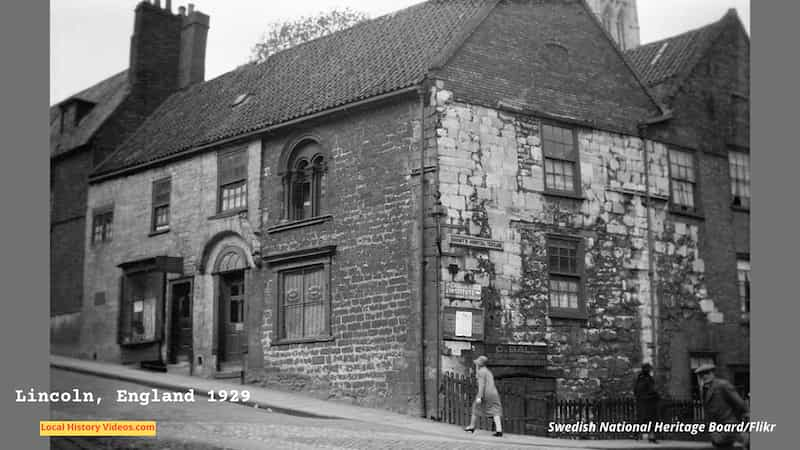
The City of Lincoln in 1935
Even in 1935, Lincoln’s history was a source of fascination for the newsreel audiences.
As the narrator in this 1935 short film described Lincoln’s small and ancient city as “picturesquely situated on the banks of the River Witham”, we see a view of beautiful old buildings, fields and trees…..and a huge great factory pumping out smoke!
The Law Courts and the Library are described as ‘modern Lincoln’, even though to our eyes they are old buildings.
There are some lovely views of the city, from its ancient structures to the high street busy with old fashioned vehicles and men in caps, and people relaxing in the park on a summer’s day.
City Of Lincoln (1935) – British Pathé (YouTube)
The City in 1942
Wartime didn’t stop the newsreel cameras visiting the historic streets and buildings of the city located in “Bomber County” – so named because of the number of Bomber Command airfields in Lincolnshire during World War II.
You’ll get no hint from this 1942 short film that Britain was three years into the Second World War. The Blitz had done significant damage to many cities and towns across the country in the previous two years, so perhaps this series of films for cinema broadcast was both a way of preserving a visual record should the locations come under attack, as well as a morale boost to remind people about the places they were suffering to protect.
There are some lovely shots of the old landmarks, including a nice one of the Newport Arch with an old fashioned car driving by. In the photo at the top of this page, which was probably taken around the end of the 19th century or just after, the arch is attached to a shop building. We can see in this film that by 1942 the building has been replaced, the new one set back from the arch so the road is given over to traffic and pedestrians can now walk round the side of the arch on a pavement.
Locations filmed included
- Lincoln Cathedral (St. Mary)
- Exchequer Gate
- Newport Arch
- Potter Gate
- The 12th Century “Jew’s House”, then being used for the Cottam & Son Antiquities shop
- The Glory Hole
- 15th Century stone bow arch
At the end are some nice shots of people going about their business in the city centre, with a traffic policemen at the junction.
Lincoln (1942) – British Pathé (YouTube)
Lincoln’s Royal Visit 1958
This is silent footage recording the visit of Queen Elizabeth II and Prince Philip to Lincoln, Scunthorpe and Grimsby in 1958.
It begins with a shot of the new Pelham Bridge. Then we see a steam train arriving at Lincoln’s railway station, and the Queen walking out of the station, where she is greeted by the Mayor of Lincoln, Councillor L Priestley. After an inspection of the of Guard of Honour, the monarch is taken to a children’s rally at Lincoln Football Ground. The Queen then arrives at Pelham Bridge to officially open it, before receiving a quick tour round the Cathedral.
Royal Visit To Lincoln, Scunthorpe & Grimsby (1958) – British Pathé (YouTube)
March 1986
This home video of a day out in Lincoln in March 1986 is just shy of seven minutes. It’s a highly enjoyable watch, and subtly reminds us how much has changed in the last few decades.
There are several different locations, with quite a few people appearing and the odd vehicle. A real trip down memory lane to see the fashions of the time.
Someone has dug up sections of the street, but there’s no safety signage, and it’s not clear if the man sitting against the hole is a workman because high-vis equipment hadn’t been introduced yet.
The slow panorama from the tower gives a nice view of the buildings in 1986, even if it was a misty day.
The final scene shows a BR train leaving the station, with mud heavily splattered half way up the sides.
Lincoln City Centre March 1986 – bonearrowgroup (YouTube)
Historic Book
Extract from “The history of the county of Lincoln” by Thomas Allen
Published 1830
Pages 66-67
“In the times immediately following the abandonment of the Romans , when the country was
torn to pieces by foreign invasions and internal feuds , when every relic of civilization was
destroyed , by a people whose only delight was in blood and warfare , the commerce of Lincoln
was neglected , and the Witham , the Foss – dyke , and the Car – dyke choaked up , and their
waters spread around the country , re – inundating a great part of what the Romans had been at
such pains to lay dry .
Lincoln , however , soon after the conquest , became the favourite residence of the Norman
sovereigns , and we find it even in the time of William I. ” one of the most populous cities in
England , ” full of trade , and resorted to both by land and water . Its commerce so much
increased , that in the time of Henry I. , but a short period from the conquest , it is stated to
have possessed ” a very large share of the import and export trade of the kingdom . ” Thus
the navigation of the Witham had been either kept open or recovered ; but it seems most pro
bable that it had been preserved by a natural course , for being a river , its course had been
marked out by nature , consequently the fall of its waters , though but small , would be sufficient
to clear its bed of any accumulation of soil or gravel , which could not be the case with either
of the others , for being artificial channels , there would always be a natural tendency to
obstruction , which could not be avoided without the application of frequent cleansing .
Lincoln at this time seems to have been the seaport of the county . Boston had not yet risen
into existence , or was a place of complete insignificance ; the river , not overloaded with cuts
and drains , as at present , permitted the tide to flow to the city walls , and ships of great
burthen found the Witham a convenient navigation . At this period , to improve the commerce
of Lincoln still further , Henry I. had the Foss – dyke re – opened , and Lincoln again assumed the
command of the Trent , thus furnishing the west countries with foreign commodities , and ex
porting their productions to foreign markets .
During the whole of this reign , Lincoln seems to have enjoyed the full advantages of its
situation , and to be once more the emporium of the midland country . The troubles of the
next reign disturbed its commerce , and though the stream and the tide kept the Witham open ,
the Foss – dyke was neglected , and its navigation considerably impeded.”
Page 246
“Richard Flemmyng , Master of Arts , and founder of Lincoln College , Oxford , was preferred
to the rectory of Boston about 1416 ; after which , growing in favour with King Henry V. and
some of the chief nobles , he was , in 1420 , raised to the bishoprick of Lincoln , and in 1425 was ,
by Pope Martin V. ( to whom he was chamberlain , ) raised to the dignity of Archbishop of
York , but the dean and chapter of the same place relinquishing him , chose John Kemp , Bishop
of London , to that see , a person better favoured by them in all respects : so that he returning
to his bishoprick of Lincoln again , spent the rest of his days in peace , and there died January
25 , 1430-31.”


